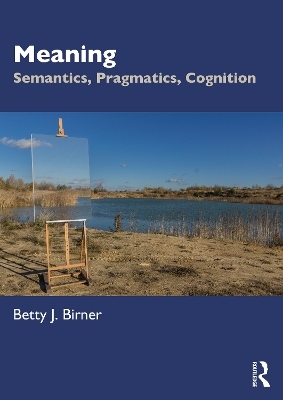
Meaning
Routledge (Verlag)
978-0-367-02884-8 (ISBN)
Meaning addresses the fundamental question of human language interaction: what it is to mean, and how we communicate our meanings to others. Experienced textbook writer and eminent researcher Betty J. Birner gives balanced coverage to semantics and pragmatics, emphasizing interactions between the two, and discusses other fields of language study such as syntax, neurology, philosophy of language, and artificial intelligence in terms of their interfaces with linguistic meaning.
Comics and diagrams appear throughout to keep the reader engaged; and end-of-chapter quizzes, data-collection exercises, and opinion questions are employed along with more traditional exercises and discussion questions. In addition, the book features copious examples from real life and current events, along with boxes describing linguistic issues in the news and interesting and accessible research on topics like swearing, politics, and animal communication. Students will emerge ready for deeper study in semantics and pragmatics – and more importantly, with an understanding of how all of these fields serve the fundamental purpose of human language: the communication of meaning. Meaning is an ideal textbook for courses in linguistic meaning that focus on both semantics and pragmatics in equal parts, with special attention on philosophical questions, related subfields of linguistics, and interfaces among these various areas.
Appropriate for both undergraduate and graduate-level courses in semantics, pragmatics, and general linguistics, Meaning is essential reading for all students of linguistic meaning.
Betty J. Birner is a professor of Linguistics and Cognitive Science in the Department of English at Northern Illinois University, DeKalb, IL. She received her Ph.D. in 1992 from Northwestern University, and has written extensively on pragmatics, the semantics/pragmatics interface, and information structure.
List of boxes
List of figures
List of truth tables
Preface
Acknowledgments
1. What is language?
Linguistics
The rules of language
Language change
Research in linguistics
Philosophy of language: How meaning works
Types of meaning
Where is meaning located?
The philosophers weigh in, beginning with: Frege
Russell
Strawson
Donnellan
The upshot
Semantics and pragmatics
Discourse models and possible worlds
Exercises
2. Semantics I: Word meaning
What is a word?
Where words come from
Historical descent
Other sources of new words
Lexical relations
Approaches to word meaning
Componential analysis
Other primitive-based approaches
Prototype theory and The Great Sandwich Controversy
Exercises
3. Semantics II: Sentence meaning
Truth and meaning
Sentential relations
Logical operators
Negation
Conjunction
Disjunction
The conditional
The biconditional
Propositional logic
Analytic statements
Synthetic statements
Predicate logic
Predicates and constants
Variables
Quantifiers
Ambiguity and scope
Exercises
4. Pragmatics I: The Cooperative Principle
Reprise: Semantics vs. pragmatics
The Cooperative Principle
The maxims
The maxim of Quantity
The maxim of Quality
The maxim of Relation
The maxim of Manner
Revisiting Grice’s problem
Tests for conversational implicature
Implicature and pragmatic theory
Conventional implicature
The Gricean world view
Pragmatics after Grice
Explicature
Impliciture
Neo-Gricean theory
Relevance theory
Boundary disputes
Exercises
5. Pragmatics II: Speech acts
Speech acts
Performatives
Constatives
Types of speech acts: first pass
Indirect speech acts
Felicity conditions
Felicity conditions, speech acts, and the Cooperative Principle
Types of speech acts: second pass
Politeness theory
Exercises
6. Language structure
The Chomskyan revolution
Sound structure
Word structure
Morphemes
Allomorphs
Words
Parts of speech
Structure and function
Representing word structure
Other ways of building words
Sentence structure
Ambiguity and constituency
Representing sentence structure
Expanding our grammar
Structural ambiguity
So what’s the point?
Exercises
7. Interfaces I: Semantics, pragmatics, and philosophy
Reference and the semantics/pragmatics boundary
What do we refer to when we refer?
Deixis and anaphora
Indexicals
Deixis
Personal deixis
Spatial deixis
Temporal deixis
Discourse deixis
Anaphora
Reference resolution
Cataphora
Anaphora and phrase types
Definiteness
Definiteness as uniqueness
Definiteness as familiarity
Presupposition
Testing for presupposition
Presupposition triggers
Theories of presupposition
Accommodation
Exercises
8. Interfaces II: Structure and meaning
Semantic roles
Argument-structure alternations
Information structure
Preposing
Postposing
Argument reversal
Inference
Open propositions
Constructions
The type/token distinction
Exercises
9. Meaning and human cognition
Language and the brain
Brain structure
Neurons
Aphasia
Language and thought
Does the language I speak affect my view of reality?
Language use and world view
Advertising
Politics and public policy
Language and prejudice
Connecting the dots
Exercises
10. Meaning, minds, and machines
The nuts and bolts
Natural-language processing
Artificial intelligence
Data mining
Deep learning
Meaning and the self
Bodies and minds
Language and consciousness
Exercises
References
Index
| Erscheinungsdatum | 15.03.2023 |
|---|---|
| Zusatzinfo | 15 Tables, black and white; 27 Line drawings, black and white; 11 Halftones, black and white; 38 Illustrations, black and white |
| Verlagsort | London |
| Sprache | englisch |
| Maße | 174 x 246 mm |
| Gewicht | 580 g |
| Themenwelt | Geisteswissenschaften ► Geschichte |
| Geisteswissenschaften ► Philosophie | |
| Geisteswissenschaften ► Sprach- / Literaturwissenschaft ► Anglistik / Amerikanistik | |
| Geisteswissenschaften ► Sprach- / Literaturwissenschaft ► Literaturwissenschaft | |
| Geisteswissenschaften ► Sprach- / Literaturwissenschaft ► Sprachwissenschaft | |
| ISBN-10 | 0-367-02884-0 / 0367028840 |
| ISBN-13 | 978-0-367-02884-8 / 9780367028848 |
| Zustand | Neuware |
| Informationen gemäß Produktsicherheitsverordnung (GPSR) | |
| Haben Sie eine Frage zum Produkt? |
aus dem Bereich


